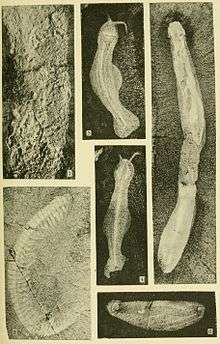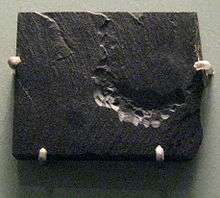Amiskwia
Amiskwia is a genus of large, soft-bodied animals known from fossils of the Middle Cambrian Lagerstätten both in the Burgess shale formation in British Columbia and the Maotianshan shales of Yunnan Province, China. It is interpreted as a member of the Gnathiferan total group.[1]
| Amiskwia | |
|---|---|
 | |
| Scientific classification | |
| Kingdom: | Animalia |
| Total group: | Gnathifera |
| Genus: | †Amiskwia Walcott, 1911 |
| Type species | |
| Amiskwia sagittiformis Walcott, 1911 | |
| Species | |
| |
Material

Very few specimens of this organism have been found, only 26 of the Burgess shale species, A. sagittiformis,[2][3] and one or two specimens of the Maotianshan species, A. sinica — which may be a reflection of its genuine rarity, but is more likely to be due to taphonomic (preservational) or behavioural factors. The fossils reach 25 mm (1 in) in length. The head is rounded, tipped with two tentacles, and appears to contain a four-ganglion brain; the body flattens out and broadens in the trunk, which appears to have been fairly muscular. Where the trunk meets the head there is a small tubular opening, which can be interpreted as the mouth; the gut terminates where the trunk narrows and meets the tail, which is broad and paddle shaped. The body morphology suggests a free energetic swimmer, which may be consistent with the dearth of fossils (in other words, a free-swimming animal would be able to avoid being buried alive in a mudflow on a regular basis, compared to a benthic animal).
History of research
Amiskwia was originally categorized by paleontologist Charles Walcott. Walcott thought he saw three buccal spines in the fossils, and therefore categorized Amiskwia as a chaetognath worm (arrow worm). However, Amiskwia appears to lack the characteristic grasping spines and teeth of other Burgess fossil arrow worms. Later scientists suggested an affinity with the nemerteans (ribbon worms), but the evidence for this was somewhat inadequate.[2] Conway Morris, on re-examining of the Burgess Shale fauna in the 1970s, described it as being the single known species in an otherwise unknown phylum, given that it has two tentacles near its mouth, rather than the characteristic single tentacle of true nemerteans. (Nemerteans do not have a single tentacle. However, a pair of antero-lateral tentacles is present in two of the many genera of pelagic nemerteans. Nemerteans do have a single eversible—normally internal—proboscis, which when everted could resemble an anterior median tentacle if fossilized. Whether retracted or everted, the proboscis is the only structure in pelagic nemerteans likely to fossilize, as it is the only structure with substantial connective tissue and muscle. The body wall has almost no muscle or connective tissue and is exceedingly unlikely to fossilize; hence, a pelagic nemertean fossil would be only the proboscis).[2] Butterfield implies from the appearance of the fossils that the organisms may have lacked a cuticle:[4] while this is also true of the nemerteans, these organisms lack a coelom and are thus unlikely to fossilise. He goes on to argue that the absence of cuticle is characteristic of the Chaetognaths; whilst teeth would be expected, a similar fossil, Wiwaxia, shows such structures in only 10% of the expected instances, and Anomalocaridids are often found detached from their mouthparts, so the absence may be taphonomic rather than genuine. The absence of spines could simply mean that the fossils represent young organisms — or that later chaetognath evolution involved paedomorphosis.[5]
Affinity
The most recent interpretation, based on all available fossil material, is that the organism was a total group gnathiferan; its precise affinity within this group is difficult to resolve, but if it falls in the stem lineage of any extant phylum then it would be a gnathostomulid.[1]
Etymology
The scientific name Amiskwia sagittiformis derives from the nearby Amiskwi River, and its sagittiform shape. "Sinica," of A. sinica, refers to that species' origin from China.
References
- Caron, Jean-Bernard; Cheung, Brittany (2019). "Amiskwia is a large Cambrian gnathiferan with complex gnathostomulid-like jaws". Communications Biology. 2: 164. doi:10.1038/s42003-019-0388-4. PMC 6499802. PMID 31069273.
- Conway Morris, S. (1977). "A redescription of the Middle Cambrian worm Amiskwia sagittiformis Walcott from the Burgess Shale of British Columbia". Paläontologische Zeitschrift. 51 (3–4): 271–287. doi:10.1007/BF02986576. ISSN 0031-0220.
- Caron, Jean-Bernard; Jackson, Donald A. (October 2006). "Taphonomy of the Greater Phyllopod Bed community, Burgess Shale". PALAIOS. 21 (5): 451–65. Bibcode:2006Palai..21..451C. doi:10.2110/palo.2003.P05-070R. JSTOR 20173022.
- Butterfield, N. J. (1 July 1990). "Organic Preservation of Non-Mineralizing Organisms and the Taphonomy of the Burgess Shale". Paleobiology. 16 (3): 247–399. ISSN 0094-8373. JSTOR 2400788.
- Kasatkina, A. P. 1982. Ŝetinkočelustnyje morej SSSR i sopredel'nyh vod.
136 pp. Nauka, Leningrad.
- Cited in Doguzhaeva, L. A.; Mutvei, H.; Mapes, R. H. (2002). "Chaetognath grasping spines from the Upper Mississippian of Arkansas (USA)" (PDF). Acta Palaeontologica Polonica. 47 (3): 421–430. Retrieved 2007-08-19.
External links
- "Amiskwia sagittiformis". Burgess Shale Fossil Gallery. Virtual Museum of Canada. 2011.
- Graphic of Amiskwia in motion